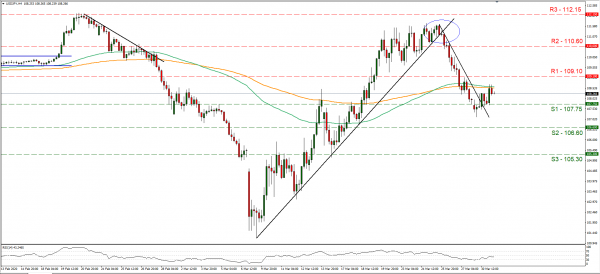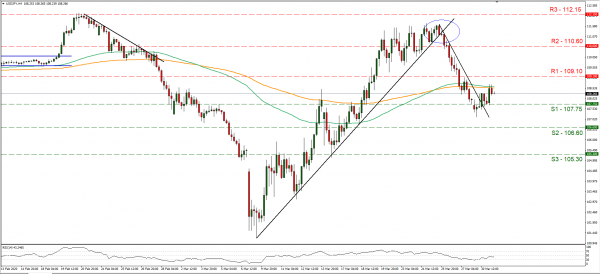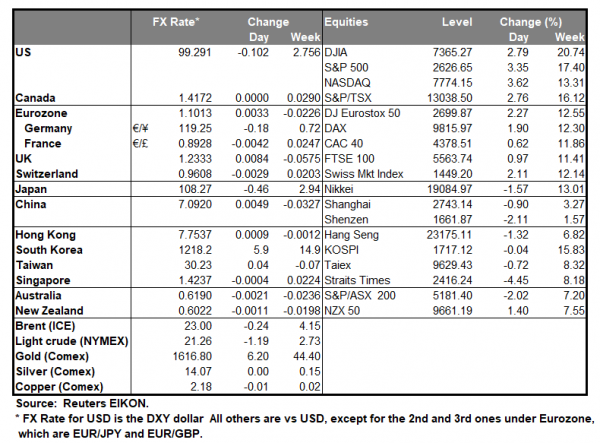The USD strengthened against a number of its counterparts yesterday, yet uncertainty remained. Analysts tend to note that Japanese investors and companies rushed to cover the shortage of USD before their fiscal year end and as today is the last trading day for Q1 also for investors elsewhere. The issue could create wider swings than usual yet we tend to retain the view that the main fundamental issue affecting the markets remains the coronavirus outbreak and its adverse economic effects. It should be noted that Japan’s economy minister Nishimura stated that a big economy package is being prepared and should the fiscal stimulus impress the markets, we could see JPY getting some support. Japanese data seemed to have little effect on JPY, yet industrial output seems to remain at low levels and traders tend to focus on tomorrow’s Tankan data. USD/JPY rose yesterday, breaking the 107.75 (S1) resistance line, now turned to support. As the pair also broke the downward trendline incepted since the 25th of March, we switch our bearish outlook for the pair, initially in favor of a possible sideways movement. Should the pair’s long positions be favored by the market, we could see it breaking the 109.10 (R1) resistance line and aim for the 110.60 (R2) resistance level.
AUD remains flat despite good Chinese numbers
The Aussie remained rather flat in yesterday’s trading against the USD after the stellar data of China’s Mfg PMI for March. Despite the indicator showing growth once again for China’s crucial manufacturing activity, substantial support seemed to be missing for the AUD as investors may still be skeptical about the rebound. Worries tend to concentrate on the return of orders to the Chinese manufacturing sector as clients in Europe and the US may present little demand at the current stage as the coronavirus has still a firm grip over Europe and spreads fast in the US. On Monday the People’s Bank of China unexpectedly cut its reverse repo rate by the most in almost five years to relieve pressure on the economy. It should be noted though that WHO issued a stark warning that the coronavirus epidemic is far from over in Asia, increasing worries. The heavy selling pressure seems to have reversed for AUD, yet as uncertainty for the coronavirus continues to increase, the outlook remains blurred. AUD/USD continued to test our (R1) 0.6180 level but did not breach it. That level was last tested on the 16th of March and currently a triangle seems to be forming between the upward trendline incepted since the 19th of March and the 0.6180 (R1) resistance line. We expect the pair to break the (R1) should it continue to remain above the prementioned upward trendline, probably today. Should the bulls actually maintain control over the pair, we could see it breaking the 0.6180 (R1) resistance line and aim for the 0.6280 (R2) resistance hurdle. Should the pair come under the selling interest of the market, we could see it breaking the prementioned downward trendline and the 0.6075 (S1) support line aiming for lower levels.
Other economic highlights today and early tomorrow
In the European session we get UK’s GDP growth rates for Q4, Germany’s unemployment data for March and Eurozone’s preliminary HICP rates for the same month. In the American session, we get the US consumer confidence indicator for March. During tomorrow’s Asian session, we get Japan’s Tankan indexes for Q1, Australia’s building approvals and China’s Caixin Mfg PMI for March.
Support: 107.75 (S1), 106.60 (S2), 105.30 (S3)
Resistance: 109.10 (R1), 110.60 (R2), 112.15 (R3)
Support: 0.6075 (S1), 0.5980 (S2), 0.5900 (S3)
Resistance: 0.6180 (R1), 0.6280 (R2), 0.6465 (R3)

















